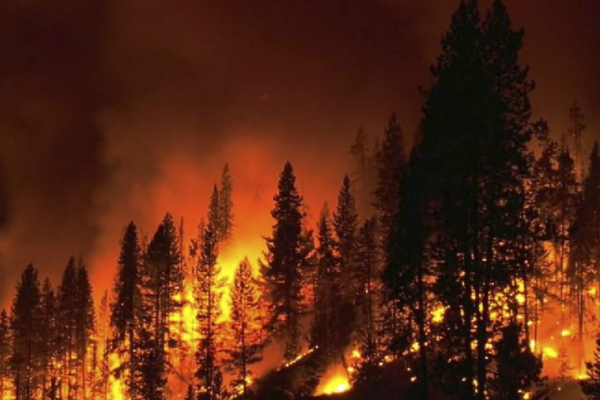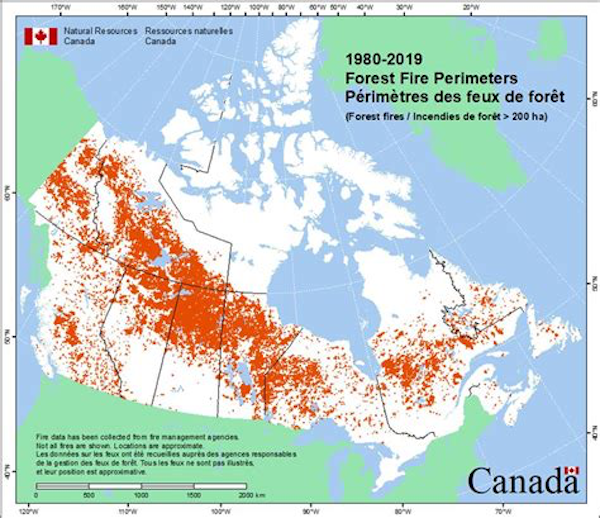Can Canada Contain Conflagration?

Image NOAA
Eleven thousand years ago, all of Canada, save the Yukon Valley, was under ice. The country was literally a blank slate. Then warming set in, the land vegetated, people entered, and white Canada evolved into a green Canada. Lightning and torch kindled fires. Green Canada burned—and has burned ever since. Climate is the grandest of the themes that frame Canadian history.
The primordial rivalry between ice and fire has deepened in recent years: the fires are more savage and frequent, the ice is melting more swiftly. This time the tempo is set not by Milankovitch cycles that regulate the intensity of solar radiation but by anthropogenic fire. People have escalated from burning living landscapes to burning lithic ones – once living, now fossilized into coal, gas, and oil. Canada began burning its combustion candle at both its ends.
The serial ice ages that erased and repopulated Canada like a palimpsest have yielded to a fire age that is rewriting history with flame. An interglacial period has morphed into an epoch in its own right. Call it the Pyrocene.
You might think that a place so vast, and so combustible, would be filled with fire traditions, a fire literature and fire art, fire institutions, a fire culture in the fullest sense. But while colonized Canada has a first-world fire establishment, and displays developed-world fire pathologies, it shows a remarkable disconnect between fire’s presence on the land and its manifestation in the culture. This is particularly true among elites who live in cities, not the bush. Only over the past couple of decades has fire entered common currency. Canada may be a firepower, but it punches below its weight internationally. Its muted presence makes a striking contrast to Australia.
One explanation points to the character of boreal Canada, and two others to how fire fits with Canadian ideas and institutions.
Begin with the boreal environment. The boreal forest, which houses the major burns, is a landscape informed by extremes, not averages, now exacerbated by global warming. Burning obeys rhythms of boom and bust. This makes planning, budgeting, and general bureaucratic operations difficult. Yet they are expected to stand between the extremes of boreal fire and ordinary life. Taking the pounding can make them unstable. Still, Alaska has managed, and Mediterranean climates present similar challenges.
The other explanations derive from the character of Canada as a confederation. The great question of culture and politics (and national identity) was how to reconcile colonies that did not want to unite, but were compelled by force, geopolitics, or economics to join together. The Anglophone-Francophone bond was both the largest and softest of these welds. There was little reason (or bandwidth left) to contemplate the boreal backcountry, other than as part of a northern economy of fish, fur, minerals, and timber. Fire control existed to keep the timber flowing.
The second is that the colonies, now provinces, retained control over their landed estate and its natural resources. Those provinces carved out of Hudson’s Bay Company lands originally held a hefty proportion of dominion lands, which were organized into national forests on the American model. In 1930 these lands were ceded to the provinces. The Canadian Forest Service imploded, surviving as a research program. Fire protection resided with the provinces. A national fire narrative disintegrated into provincial and territorial subnarratives. The closest American analogy to the provinces may be Texas (imagine a U.S. consisting of 10 clones of Texas).
The provinces struggled to muster enough resources to handle the big outbreaks of fire. Nearly all had a northern line of control beyond which they let fires burn. Not until a round of conflagrations between 1979 and 1981 pulverized western Canada and Ontario did pressure build to create an institution that would allow provinces to share firefighting resources on a national scale. A mutual-aid agreement with the U.S. stumbled because the U.S. wanted to sign a treaty between nations, not between a nation and separate provinces. The compromise was to craft a Canadian Interagency Forest Fire Center as a corporation (not a government entity). If the U.S. too readily nationalizes fire policies better left to local authorities, Canada fails to nationalize what exceeds provincial interests.
The Canada-U.S. Reciprocal Forest Fire Fighting Accord granted Canada access to a continental-scale cache of firefighting resources (and the U.S. access to Canadian aid when needed). But the fires have grown meaner, larger, and more frequent, well beyond the capacity of even wealthy nations to corral. Fires have blasted through Fort McMurray, Slave Lake, and Lytton. They burrow into organic soils, the major reservoir of carbon in the boreal biome. Now their tag-team smoke palls have flooded Toronto and New York, Ottawa and Washington, D.C. The burning of lodgepole pine and tar sands are measurably perturbing the global climate. Canada’s fire practices have leaped well beyond its provinces.

Image Natural Resources Canada
The argument grows, moreover, that relying solely on fire suppression only aggravates the crisis, that excluding fire leaves more of the living landscape available to burn even as climate change powered by burning lithic landscapes bolsters its propensity to burn. Most analysts plead for better forest, land, and fire management programs that work with fire. Forty years ago Parks Canada began this transformation, and now fields a world-class fire program. The Canadian Forest Service continues to publish stellar science. Most of the larger provinces have fire control organizations that rival anything of their peers; on fire technologies like pumps and aircraft, Canada excels. Ongoing reconciliations with First Nations promise a recovery of indigenous fire knowledge. Yet the whole seems less than its parts.
It’s not enough. The Pyrocene is coming to Canada with the scale and power of the Laurentian ice sheet. The country needs to find ways to leverage its many fire talents not just to advance a global good but because Canada may become ground zero for a fire age. A shift will mean burning some woods rather than logging them, and not burning bitumen and oil that Canada has in the ground. It means matching firefighting with fire tolerating or outright fire lighting. It means kindling in the minds of its literati and elites an appreciation that fire is an indelible – and fascinating - part of living in Canada, as recent books by John Vaillant, Alan MacEachern, and Edward Struzik demonstrate. It means accepting that, in the global economy of carbon, Canada is a superpower that needs to craft a confederation of institutions, ideas, and tools that can grant it a cultural and geopolitical presence commensurate with its conflagrations.
On the Canadian Red River Exploring Expedition of 1857, Henry Hind observed of a massive fire that “It is like a volcano in full activity; you cannot imitate it, because it is impossible to obtain those gigantic elements from which it derives its awful splendor.” We still can’t control those elements, though we have managed to disrupt them and so boosted their power. But we can control our response.